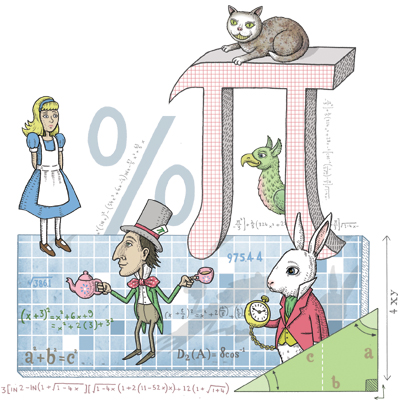Nature 454, 580-581 (31 July 2008)
Lewis Carroll in Numberland: His Fantastical Mathematical Logical Life
by Robin Wilson
Allen Lane/Norton: 2008. 237 pp./208 pp. £16.99/$24.95
reviewed by Jascha Hoffman
Legend has it that Queen Victoria was so enchanted by Alice's Adventures in Wonderland that she insisted on Lewis Carroll's next work being sent to her. One can imagine her expression as she opened the book that arrived, entitled An Elementary Treatise on Determinants.
Charles Lutwidge Dodgson had many careers. He is best remembered for the sublime nonsense verse he wrote under the name Lewis Carroll. He was a pioneering childrens' photographer and a lay clergyman admired for his sermons. Before all else he was a mathematician who taught generations of students at the University of Oxford, UK, contributed to the fields of geometry, algebra and logic, and used games and puzzles to entertain and instruct. In Lewis Carroll in Numberland, mathematician Robin Wilson reveals Dodgson to be the grandfather of recreational mathematics.
He was precocious, orthodox and craved variety. Born in 1832 in Cheshire, UK, Dodgson was a lecturer at Oxford by his early twenties. At a time when non-Euclidean geometries were catching on, he wrote a four-act play stubbornly arguing that Euclid should remain at the centre of the Oxford curriculum. He invented a method to find the determinants of large matrices, but his strange notation meant that it never caught on. Later, he sought mathematical remedies for real injustices, suggesting tie-break methods for parliamentary elections to his friend Lord Salisbury, and devising a way to make lawn tennis tournaments fairer to the runners-up.
Some work was ahead of its time, especially his efforts to bring mathematics to young people. Although pupils complained of his "singularly dry and perfunctory manner" in the classroom, Dodgson's gift for teaching shone through in dozens of self-published guides for students, and in his letters to children. Wilson shows that he found humour in the plainest of subjects and did not underestimate his young correspondents, once commenting that intelligence seemed to vary inversely with size. In person, he drew their attention using guessing games and feats of memory. He could recite the first 71 digits of pi using a series of nonsense couplets as memory aids, and once contrived an algorithm that could give the date of every Easter Sunday until 2499.
Sooner or later every child who knew Dodgson would receive a brain teaser. Published in collections with titles such as A Tangled Tale and Pillow Problems Thought Out During Sleepless Nights, many of these word problems required the dutiful application of algebra, trigonometry or geometry. Some needed mere patience and common sense. One devious puzzle asked how many guests would come to a dinner party if a man invited his father's brother-in-law, his brother's father-in-law, his father-in-law's brother, and his brother-in-law's father. Others were in the form of fallacies to debunk. Dodgson once asked a 14-year-old boy to find the flaw in his proof that 2 + 2 = 5, which Wilson reveals to be a stealthy division by zero. A few problems hinged simply on a pun.
Later in life, Dodgson taught symbolic logic with a board game that used red and grey counters on a set of nested squares, which he believed superseded the overlapping circles championed by British logician John Venn. In Dodgson's Game of Logic, published under his pen name to gain a wider audience, one can see some of the punctilious lunacy of the Mad Hatter. Following chains of inference he called 'sillygisms', he led readers from reasonable premises to conclusions such as "Babies cannot manage crocodiles", "No banker fails to shun hyaenas" and "No bird in this aviary lives on mince-pies". These examples are perhaps less interesting as logic than as the stirrings of a systematic kind of literature, also apparent in his symmetrical poem that can be read vertically and horizontally.
Lewis Carroll in Numberland is not a conventional biography. Robin Wilson has winnowed Dodgson's prodigious output into a first-rate scrapbook of proofs and puzzles. Sadly, his tone is often fawning and flat — not up to the standard of mathematical storytelling he set in his previous book, Four Colours Suffice (Allen Lane, 2002), on the history of the conjecture that four colours can fill any map without any bordering countries sharing a colour. By immersing us in Dodgson's correspondence, however, Wilson conjures the spirit of a man who delighted in paradox yet insisted on precision, who held fiercely to the ancients while straining to understand the world around him, and who wanted most of all to stump everyone he knew. Writing for work or pleasure, for children or adults, Wilson shows that Dodgson turned the most sober of problems into child's play.
"Some perhaps may blame me for mixing together things grave and gay," he wrote as Lewis Carroll in an insert to his nonsense poem The Hunting of the Snark. But, he continued, "I do not believe God means us thus to divide life into two halves."
